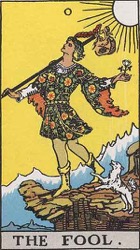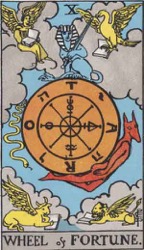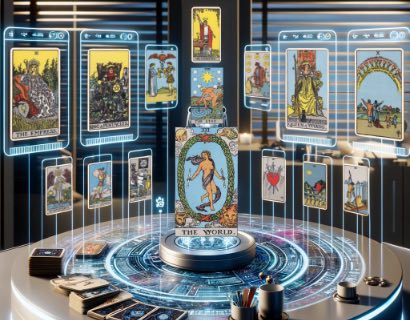The World Tarot Card Meaning & Interpretations

In beginning to understand the meaning of this card let us begin with its name. The names assigned to some cards in the tarot deck can often mislead, or misdirect, from what the true meaning of the card is. The name is probably the place we start from before we even begin to take in what the picture is telling us. The Fool automatically makes us judgemental towards its character. The Lovers suggests a sexual context when it is really about choices and irreversible decisions. So begin by asking yourself what does the word World mean to you? Do you think of planet Earth as the World? Or do you consider it to encompass the entire Universe? We talk about heaven and earth as the two distinct planes of the spiritual and material. Do you consider The World to embody the latter or both? The word comes from the old German meaning "Age of Man" or "Domain of Man". However the Latin equivalent mundus, from which this Tarot card's original Italian name Il Mondo comes from, means "clean, elegant". The Latin word borrowed from the Greek word Cosmos meaning "orderly arrangement" the opposite, in Greek, being "Chaos". It was Pythagoras who first used the word Cosmos to describe the Universe.
Some modern decks have incorporated, in the background of this card, an image of planet Earth. The Rider Waite Smith (RWS) deck changed most of the cards in Tarot but not this one, A.E Waite described the card as "unchangeable". Traditional tarot decks, including the RWS, depict this card as a woman standing, or dancing, inside a oval laurel which symbolises a Yoni, womb or female reproductive organs. This detail may suggest a meaning of birth, re-birth or fertility.
The World and The Empress are connected through numerology as both are 3s. As card 21 of the Major Arcana its numerology is 3 when 21 is reduced (2 + 1 = 3). Both cards relate to fertility and nurturing but with The World this isn't so focused on the physical and material as The Empress, but on the spiritual and divine. There is one other 3 in the Major Arcana which shares a visual detail. Notice in the traditional depictions, including the RWS deck, that the woman in The World has her left leg crossed behind her right leg. This same detail is found in card 12 of the Major Arcana The Hanged Man. This crossed legs is an ancient symbol known as a fylfot in the West and swastika in the East. This is not a symbol of hate, as it was mis-used in the middle of the 20th century, but an ancient and sacred symbol of the eternal wheel of life. In India it is a symbol of health, luck, success and prosperity and in Europe it can be found in the stained glass windows of some churches. If The World represents a womb and birthing then The Hanged Man would represent a child coming head first from it. Both cards together would be a good omen for an expectant mother worried about the birth.
In the RWS deck the character's body indicates motion to the right, or west, symbolising heading in the right direction. Compare this to The Fool, in the same RWS deck, who is heading in the wrong direction. The World character looks over her shoulder, in a mirror image of the thief in the 7 of Swords. The thief is heading in the wrong direction looking over his shoulder towards the future and correct direction. The World character is looking back at the past, at the road she has travelled. This is an important detail as The World often symbolises being in a better position to make decisions with the benefit of experience. If it is the final outcome card, in a tarot spread, it could mean that you may change your opinion on something, or someone, when you reach the end of that cycle or situation. Like climbing to the top of a hill or mountain, to get a better view of the surrounding landscape, your situation needs you to be in a better position to fully understand it.
The final visual detail in The World is a biblical one. In each corner of the card, seen in the traditional decks and the RWS, is a face of the "four living creatures" Ezekiel describes in the old testament (Ezekiel 1:1-10) . They are also described in John's vision in Revelation (4:6–8) as sitting around the throne in heaven. These four characters are also found in the The Wheel of Fortune card of the RWS deck. Some consider The Fool to represent our struggles through life, and the many trials we must learn from, culminating in a final Judgement before attaining heaven, ascension, enlightenment or re-birth represented by The World. In a non-spiritual interpretation of this card it may mean successfully reaching a finishing line and completing something.
"The Lama Ngawang Kalzang had been meditating for twelve years in various caves and retreats in the wilderness of the mountains of Southern Tibet ..... The world had forgotten him, and he had forgotten the world. This was not the outcome of indifference on his part but, on the contrary, because he had ceased to make a distinction between himself and the world. What actually he had forgotten was not the world but his own self, because the ‘world’ is something that exists only in contrast to one’s own ego." - from "The Way of the White Clouds" by Anagarika Govinda
The World can symbolises completion, accomplishment, victory, travel overseas and expansion of horizons. A happy card to find in any spread it is the final card of the major arcana and therefore symbolic of the end of the journey of The Fool through all 21 major cards. It represents an ultimate goal achieved, a pinnacle in life. In its simplest interpretation this card may point to travel abroad to other continents, environmentalism or world affairs, or even simply travel documents such as a passport. As a person it could represent a foreigner. This card also symbolises fertility and reproductive organs.
© Phuture Me Ltd 2010-2019. All rights reserved.
THE PICTORIAL KEY TO THE TAROT
By Arthur Edward Waite (1911)
As this final message of the Major Trumps is unchanged--and indeed unchangeable--in respect of its design, it has been partly described already regarding its deeper sense. It represents also the perfection and end of the Cosmos, the secret which is within it, the rapture of the universe when it understands itself in God. It is further the state of the soul in the consciousness of Divine Vision, reflected from the self-knowing spirit. But these meanings are without prejudice to that which I have said concerning it on the material side.
It has more than one message on the macrocosmic side and is, for example, the state of the restored world when the law of manifestation shall have been carried to the highest degree of natural perfection. But it is perhaps more especially a story of the past, referring to that day when all was declared to be good, when the morning stars sang together and all the Sons of God shouted for joy. One of the worst explanations concerning it is that the figure symbolizes the Magus when he has reached the highest degree of initiation; another account says that it represents the absolute, which is ridiculous. The figure has been said to stand for Truth, which is, however, more properly allocated to the seventeenth card. Lastly, it has been called the Crown of the Magi.
Related Tarot Cards
 |
 |
 |
 |
© Phuture Me Ltd 2019. All rights reserved.
